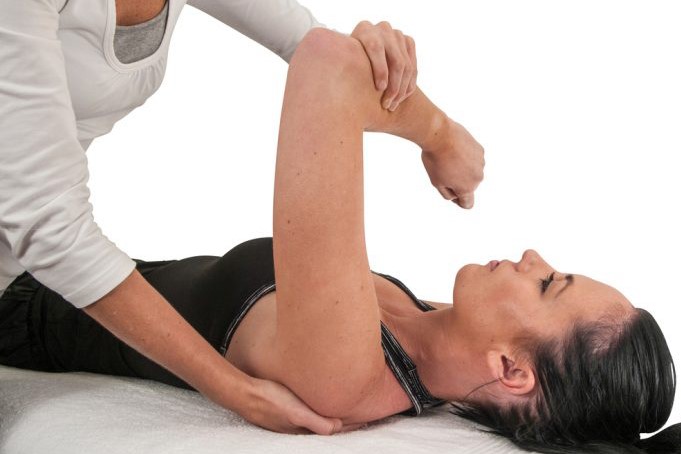
Dislocation of the shoulder: how to reduce it? An overview of the main techniques
Dislocation of the shoulder occurs when the spherical head of the humerus protrudes from its rounded cavity in the scapula
Shoulder dislocation: main features
- When a shoulder is dislocated, the humerus is usually forced forward out of the joint.
- The shoulder may appear deformed and is usually very painful.
- Often, the doctor can make a diagnosis of a shoulder dislocation by examining the shoulder itself; however, an X-ray is taken to confirm this.
- The doctor can correctly reposition the joint without surgery, often after administering medication to help tolerate the procedure.
Many techniques are available to reduce a closed shoulder dislocation
No one technique is universally effective, so practitioners must be familiar with them.
Techniques for reducing an anterior shoulder dislocation include
- Davos self-reduction technique (Boss-Holzach-Matter)
- External rotation (e.g. Hennepin technique) with abduction (e.g. Milch technique) if necessary
- FARES technique
- Scapular manipulation
- Stimson technique
- Traction-contraction
The original Hippocrates technique (the operator’s heel is placed in the affected axilla to create a countertraction) causes injury and should not be performed.
Kocher’s technique, which forcibly uses the humerus as a lever, also has a high risk of complications and should not be performed.
Reduction techniques for anterior dislocations generally use axial traction and/or external rotation.
There is no single preferable or perfect technique.
It is more important for practitioners to be familiar with different techniques and to use those that are appropriate for the dislocation and the patient’s clinical status (see Anterior dislocation of the shoulder: treatment).
Reduction attempts, particularly those performed without sedation, are more likely to be successful if the patient is relaxed and cooperative.
Shoulder dislocation reduction techniques: analgesia and sedation can help relieve muscle spasm
Patients should receive analgesia.
However, if the patient wishes, a reduction attempt without analgesia can be performed with a gentle reduction method (e.g. Davos, scapular manipulation, Hennepin or FARES).
Intravenous analgesia and/or an intra-articular injection of anaesthetic may be administered immediately during the initial assessment to relieve pain during radiographs and other preoperative procedures.
Procedural sedation and analgesia can be used for patients who have a lot of anxiety and muscle spasms and for reduction methods that require more force (e.g., traction-contraction and Stimson).
The reduction of a posterior dislocation or an inferior dislocation (luxatio erecta) usually involves a traction-contraction technique.
Whenever possible, an orthopaedic surgeon should be consulted before reducing these dislocations.
Neurovascular damage may result from the dislocation (most often with an anterior dislocation) or from the reduction procedure.
Joints should be reduced as soon as possible because delays increase the risk of neurovascular complications.
To avoid increasing muscle spasms, all reductions are performed gently and gradually, and reduction methods that use less force should often be tried first rather than those that use more force.
The choice of a gentle method is particularly important if a brachial plexus injury is suspected.
Neurovascular assessments are performed before the procedure and after each reduction attempt.
The examination includes assessment of the distal pulses and digital capillary refill time (axillary artery), tactile sensitivity of the upper arm (axillary nerve) and function of the radial, median and ulnar nerves (brachial plexus).
It is necessary to consult an orthopaedic surgeon, prior to dislocation reduction, if the patient has a complicated shoulder injury, such as a
- Fracture of a major tuberosity with a displacement of > 1 cm
- Severe Hill-Sachs injury (≥ 20% humeral head deformity due to impact against the glenoid labrum)
- Surgical neck fracture (below the greater and lesser tuberosities)
- Bankart fracture (anteroinferior glenoid lip) involving more than 20% bone fragment and with glenohumeral instability
- Proximal humerus fracture in 2 or more parts
Other reasons to consult an orthopaedic surgeon before shoulder dislocation reduction include
- The joint is exposed (i.e., an open dislocation)
- The patient is a child, because epiphyseal detachment (growth cartilage) is often present
- The dislocation is older than 7-10 days, so there is an increased risk of damaging the axillary artery during reduction, especially in elderly patients
An orthopaedic surgeon should be consulted after 2 or 3 failed attempts at closed reduction or after a successful reduction if
- A complicated shoulder injury is suspected (e.g., dislocation plus fracture, axillary nerve injury, or rotator cuff tear)
- The patient has a dislocation for the first time
However, in all patients, if a neurovascular deficit is present, reduction should be performed immediately.
If an orthopaedic surgeon is not available, a closed reduction may be attempted, using a suitable minimum force; if the reduction is unsuccessful, it may need to be performed in the operating room under general anaesthesia.
Post-reduction X-rays should usually be performed to verify the success of the reduction and to check for further fractures.
However, radiographs may not be necessary for patients with recurrent non-traumatic anterior shoulder dislocations.
Read Also:
Intraosseous Access, A Life-Saving Technique In Emergency Shock Management
Electromyography (EMG), What It Assesses And When It Is Done


